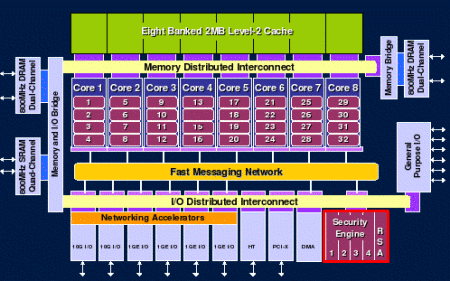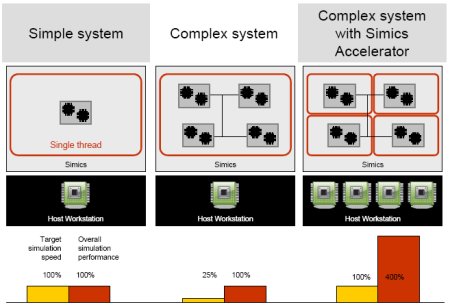Simulation platform adds full-system checkpointing
Jul 28, 2009 — by Eric Brown — from the LinuxDevices Archive — 14 viewsVirtutech announced that its Linux-compatible Simics virtualized systems development (VSD) simulation platform now supports full-system checkpointing for SystemC-based transaction-level modeling (TLM). The company also announced that Simics has added support for multi-core RMI XLR MIPS64 and Tensilica Xtensa cores.
Introduced in 2002, Virtutech's Simics is a mature VSD board simulation environment that has been used to simulate processors such as Freescale's MPC8572E PowerQUICC III and QorIQ processors. According to Michel Genard, VP of marketing, over half of Virtutech's customers run Simics on Linux (See farther below for more background on Simics, as well as an interview with Genard.)
Full-system checkpointing
With Simics' new full-system checkpointing for SystemC-based TLM, OEM and semiconductor developers can save, restore, and share the full-system state, says Virtutech. As a result, they can bypass system boot and restart steps, and share the system among team members, says the company. Other touted benefits include the ability to more easily capture and duplicate bugs, parallelize testing, and offer product training from virtual platforms.
The checkpointing feature is said to support mixed architectures and offer more advanced features than simple save and restore function for individual elements of a SystemC virtual platform. Simics also provides support for checkpointing with models written in C, C++, and Python, says Virtutech.
The checkpoint feature can capture a snapshot of the complete system that can be restored at any point or location, or on any host, helping to reduce interruptions of software development, integration, and test efforts, claims the company. Working with mixed modeling languages, the checkpointing feature is touted as offering language freedom, portability across model versions, differential saving of memory and disks, easy modification of model abstraction levels, and archiving of multiple target setup configurations.
RMI XLR MIPS64 and Tensilica Xtensa support
With the new release, Simics adds support for the multi-core and multi-threaded RMI XLR family of MIPS64-based processors, as well as Tensilica's Xtensa core, says Virtutech. Developers can use Simics to create virtualized systems comprised of the Linux-compatible RMI or Tensilica cores side-by-side with other supported processors, DSPs, or boards, says the company.
RMI's XLR processors are aimed at communications, networking, wireless, and security applications, says the company. They integrate four or eight MIPS64 cores clocked up to 1.5GHz. Each core is said to implement fine-grained, four-way multi-threading, for the equivalent performance of 16 or 32 separate cores.
RMI also offers a low-cost XLS version of the XLR, and earlier this year it announced a superscalar, 40nm-fabricated XLP processor family that can support both data- and control-plane processing. The initial XLP832 model can mix eight "EC4400" cores clocked at 500MHz to over 2GHz, says RMI.

XLR architecture
Its Xtensa 7 cores, introduced in 2006, target low-power applications, such as embedded control and digital signal processing. In its most basic configuration, Xtensa 7 compares to ARM's ARM7TDMI-s cores, albeit with more performance and lower power, Tensilica said at the time.
Simics background
Prior to adding the new MIPS and Tensilica support, Simics supported ARM, PowerPC, and x86 architectures, and last October, the company announced support for Renesas Technologies' SH-4A superscalar system-on-chip (SoC). The technology was also used by Wind River to develop its recently introduced Wind River Hypervisor, says the company.
Simics is positioned as providing "whole board" simulation with "cycle-accurate" instruction-set emulation, for meaningful hardware evaluation as well as software evaluation. Simics is said to be capable of running unmodified production-quality binaries, and can be used with third-party software development tools.
Simics does not require the OS to be paravirtualized — adapted to run on the simulated processor — and can run unmodified software from the driver, OS, stack, and application, says Virtutech.

Simics Accelerator conceptual diagram
(Click to enlarge)
A chat with Virtutech's Michel Genard
In a recent interview, Virtutech VP of marketing Michel Genard told LinuxDevices.com that the chief competitor for Simics among Linux developers is the popular, open-source Qemu emulator. However, as scalability, complexity, and multi-core support enter the picture, developers tend to look at products like Simics, he said.
"Simics scales extremely well, so we have the infrastructure to handle complex systems," said Genard. "If you have a farm or cluster of servers in your network, you can distribute and manage your simulation costs across the servers."
Genard also touts Simics for being cross-platform. "One reason Wind River chose Simics for developing its Hypervisor was that they wanted to support both Linux and VxWorks, and Simics is one of the few solutions that run independently of the target OS," said Genard.
Simics is increasingly being used in SoC design, said Genard. Here, he cited Synopsys as a leading competitor, as well as platform-specific software, such as Cavium's simulation platform for its Octeon processors.
In the world of processor simulation, Virtutech offers the advantage of spanning both the processor- and board-level worlds, claimed Genard. "You have a lot of SoC vendors that provide their own instruction sets, but they are not helping customers build a full system or board," he said. "Simics can also integrate components like FPGAs, backplanes, and other systems. You really want to have a way to represent the full system."
In processor simulation, Simics is primarily being used in the development of multi-core SoCs, due to their greater complexity, said Genard. "Multi-core is one of the use cases where we have seen more interest in virtualization at the simulation level." he said. "Multi-core is also where we see the most promise for Simics. It's not only a driver to help customers deploy multi-core systems, but we are already seeing it as an enabler of development tools around multi-core."
Testimonials
Stated Mark Burton, managing director of GreenSocs Ltd, "As SystemC transitions towards becoming a more supported design language for ESL, full-system checkpointing for SystemC is one of the features that customers are beginning to expect and request from tool vendors, The use of checkpointing will increase model accuracy, development team productivity, and it is a feature that is critical to broadened adoption and use cases for SystemC models."
Stated Mark Litvack, director of business development, RMI, "Simics support for the RMI XLR MIPS64 multithreading processor cores enables developers to create fast, virtual models of complex RMI-based platforms that can connect with additional boards and complete racks of equipment across standard networks."
Stated Chris Jones, director of strategic alliances, Tensilica, "Fusing Tensilica's software tools and components with Simics capabilities enables earlier integration of Tensilica's IP into the customer's product."
Availability
The new version of Simics supporting full-system checkpointing, as well as RMI XLR and Tensilica Xtensa processor appears to be available now.
Virtutech will discuss Simics at the DAC conference at the Moscone Center in San Francisco this week, held through Friday, July 31. Sessions at which Virtutech will present include "The Wild West: Conquest of Complex Hardware-Dependent Software Design," on July 30, in room 131. More information on Simics may be found here.
This article was originally published on LinuxDevices.com and has been donated to the open source community by QuinStreet Inc. Please visit LinuxToday.com for up-to-date news and articles about Linux and open source.